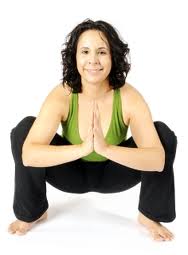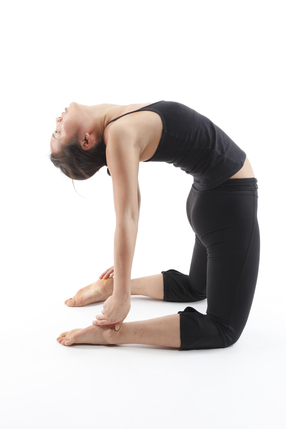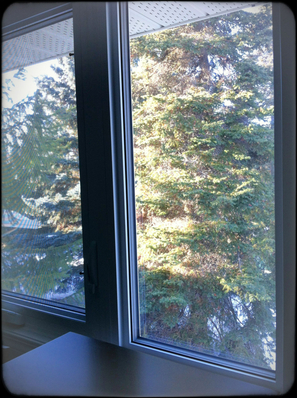|
It amazes me how adaptations can happen without even realizing it. After years of practicing yoga, I'm not sure if I truly respect how much my body has "improved", or shall I say, my flexibility and strength has improved. Using props for support has been essential to get into poses that seem challenging.
Adaptation isn't more evident than in deep squat/sitting down pose (Upavesasana) or garland pose (Malasana). Notoriously tight calves, particularly the right, have been my greatest weakness in this pose. I've placed foam blocks under my heels for many years just to get into the correct position. But, I'd have to say over past couple years (maybe increased flexibility of my joints during pregnancy), I've been very capable to flex at my ankles which allows me to get so low! Now that low position has always made me question the pose because of my earlier schooling, is the deep squat not good for the knees? Interestingly, if you ever watch a baby or toddler squat, it is the same position as squat or garland pose. So, with that being said, this pose is probably more innate and natural than a higher positioned "fitness" squat. In searching out more about this pose, I came across some interesting discussions. As noted above, there are two names for this pose. Not to get into much detail, it seems that there has been debate as to how the Sanskrit name was translated. What seemed to resonate in most places was that this pose is related to digestion and excrement (I see how the pose may have been a traditional position to go to the bathroom in!) Physically, the squat position is stretching the low back, hamstrings and calves. Strength is required in the thighs and front of the shins to maintain the pose. I find the arm positioning (hands in prayer position with the upper arms pressing into the fleshy part of the thighs) maintains my balance and stability. I can't think of any other pose that releases my low back in the same way and really relaxes the pelvic floor through gravity. Squatting seems to have many health benefits and particularly helpful for preparing for birth. I recently tried to hold my squat for a minute. Yikes! More time is needed for additional adaptation to occur. The nice thing with the squat is many variations also exist with this pose so options (in a chair, against a wall) and props (blocks, strap, rolled up mat) can help support the pose. Looking for more adaptation, LW
0 Comments
I've been thinking a lot about the camel pose (Ustrasana) lately. Maybe is it because I sing "Alice The Camel" song on a daily basis but also it has been key for me to work on backbends. I've already written briefly about backbends, which has been essential to help with opening my chest and slouchy shoulders due to late night nursing and carrying baby and baby things. But these aren't the only reasons I am drawn to the camel pose... This past year has been one of many changes for me. The most significant change was becoming a mom. In light of this, I realized the camel can be symbolic of my journey so far on two fronts. 1. Camels have reserves of water, and I, like the camel, have been delving into my reserves many days over the past year. My thirst for knowledge (when does my baby eat this or that?), patience (when will he sit by himself?), and sleep (how long will he sleep tonight?) have been constant. I really didn't know exactly what I was signing up for with motherhood and recently I've reflected on what has changed. Part of me is experiencing loss (of a life I had pre-baby) but it is greatly overshadowed with the presence of my fantastic son. Reading the book, Momma Zen by Karen Maezen Millera, has been a breath of fresh air (recommended by a yoga teacher and mom) and it too has been nourishing my soul. 2. Camels are work animals who carry heavy loads. I, too, have been literally and figuratively carry a heavy load. As I stated above, I'm carrying a 25 pound toddler many places and all his associated things. But I'm also carrying the load of being the primary care giver to this child for, let's say, another 18+ years of my life. Not a light load but something I am ready to take on. I look to the camel pose now as a physical chest opener but also an energizing pose to allow me to open up to change and to refuel my reserves. Interestingly, chest opening is thought to release dramatic emotional displays and I am ready for this vulnerability. In one of my yoga books, it is listed as exhilarating! All in all, camel pose is an advanced pose which has many alternatives to allow almost anyone to try it. In my research, it is common for some people to actually experience nausea and lightheadedness during this pose due to the extension of the back and neck. So some cautions need to be taken.
Ready for the humps and bumps ahead...and now I know more about camel pose and how it can help! LW Simplicity. Keep It Simple Silly (or whatever "S" word you'd like to use). This past week I ended up practicing in my master bedroom of all places. I am very lucky to have a gorgeous view out of my window of tall green conifer trees and blue skies (most days!) so I opened my blinds to let the beautiful view be seen. It was an impromptu session where I'd been debating whether or not to practice. My achey sick body wasn't sure it was ready for anything. But I persevered and went through my poses. As I was transitioning into tree pose (Vriksasana), I had the oddest feeling that someone was watching me. My peripheral vision was giving me the cues that someone or something was there. And there perched on the stunning tree was my backyard squirrel, at perfect visual height, enjoying a red berry. I couldn't help but chuckle to myself that I had an audience during my most sluggish practices in a long time! But what the squirrel reminded me was to keep things simple. And isn't that what yoga is about too. He was just chilling out on a tree branch (two-stories up), enjoying his morning snack. It was his nourishment and the yoga was mine. We can get really bogged down with life and can forget simple pleasures. In this morning's practice, I was reminded to take a deep breath and let the simple things be what is most important. Nature can be our greatest teacher. Have a moment for yourself and remember to KISS, LW Coming from a group exercise model, it just seemed appropriate that yoga classes would have music. And practicing at home to my one and only VHS (yes, that is how long ago that was!), it was to music. So the first class I attended that had no music, I was a bit put out. Can I really practice yoga in silence?
After getting use to there being no music, I actually enjoyed the silence. And really the silence wasn't always happening because depending on the class, breathing techniques were utilized and I could listen to my own breath. This past week, I practiced to Krishna Das and it got me thinking about what is the rule about playing music in a yoga class. Is there a rule? I didn't find anything concrete for an answer, only opinions about to use or not to use music. I suppose it is at the discretion of the teacher and his/her ability to pick appropriate tunes. There are many pre made options, which likely make it easier. Check out here, here and here about some opinions about music and yoga practice. Does your yoga practice include music? What do you prefer? LW |
Aspiring Yoga TeacherI've practiced yoga since I was a pre-teen and have always found it to keep me centered. I will be a teacher one day and this is my journey to discover teaching and practice. Archives
April 2019
Categories
All
|
Edmonton, Alberta




 RSS Feed
RSS Feed